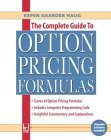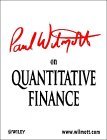
From the Back Cover
The first Sourcebook to Explain Every Important Option Pricing Formula. When pricing options in today's fast-action markets, experience and intuition are not longer enough. To protect your carefully planned positions, you need precise facts and tested information that has been proven time and again. The Complete Guide to Option Pricing Formulas is the first and only authoritative reference to contain every option pricing took you need, all in one handy volume: Black-Scholes, two asset binomial trees, implied trinomial trees, Vasiceck, exotics. Many important option pricing formulas are accompanied by computer code to assis in their use, understanding, and implementation.
This invaluable, one-of-a-kind reference work gives you: a complete listing of key option formulas, all delivered in an easy-to-use dictionary format; Commentary that explains key points in the most important and useful formulas; Valuable software and ready-to-use programming code that enhances your understanding of option pricing models and their practical implementations; Practitioner-oriented formulas, and highlights of the latest option pricing research from major institutions worldwide; Pricing advances on commodity options like the Miltersen and Schwartz Model, exotic options such as extreme spread options and implied trinomial trees, and much more! Professionals who use options must have immediate access to reliable and complete option pricing formulas and information. The complete Guide to Option Pricing Formulas, an invaluable guide for both experienced users and those learning how to use the tools of valuation, is the first book to place all of the research and information you need at your fingertips.
ABOUT THE AUTHOR Espen Gaarder Haug is a leading expert on derivatives theory and its practical implications. He has developed systems and tools for options and interest rate derivatives for the Chase Manhattan Bank Derivatives Research and Training Group (Europe), and also worked for several years in derivatives research and trading for Chemical Bank and Den Norske Bank. Haug is a greatly appreciated lecturer on derivatives in graduate finance programs and among practitioners. Further, he has published numerous articles on options in academic journals, including the Journal of Financial Engineering.

Product Description:
An unprecedented book on option pricing! For the first time, the basics on modern option pricing are explained ``from scratch'' using only minimal mathematics. Market practitioners and students alike will learn how and why the Black-Scholes equation works, and what other new methods have been developed that build on the success of Black-Shcoles. The Cox-Ross-Rubinstein binomial trees are discussed, as well as two recent theories of option pricing: the Derman-Kani theory on implied volatility trees and Mark Rubinstein's implied binomial trees.
Black-Scholes and Beyond will not only help the reader gain a solid understanding of the Balck-Scholes formula, but will also bring the reader up to date by detailing current theoretical developments from Wall Street. Furthermore, the author expands upon existing research and adds his own new approaches to modern option pricing theory. Among the topics covered in Black-Scholes and Beyond: detailed discussions of pricing and hedging options; volatility smiles and how to price options ``in the presence of the smile''; complete explanation on pricing barrier options.

Product Description:
In this two-volume work Paul Wilmott, described by the Financial Times as a "cult derivatives lecturer", updates and extends - with 18 new chapters - his earlier classic Derivatives: The Theory and Practice of Financial Engineering (also published by John Wiley). The new material includes chapters on technical trading, volatility modeling, utility theory, trader options, modeling dividends, real options, energy derivatives and analysis of recent derivatives-led fiascos.
Throughout the book's incredibly wide breadth, the author presents to the reader all current financial theories in a manner designed to make them easy to understand and implement. The reader will discover what the author thinks of certain theories, and where an existing concept is dismissed as impractical or unworkable it is always replaced with one of the author's own, alternative theories. Reviews of Derivatives: The Theory and Practice of Financial Engineering.
"It is a serious work that takes the reader all the way from the simplest of notions to the most complicated of recent models. In short, it is the most comprehensive and up-to-date textbook on options that I have seen ... The style is jocular, but the content heavyweight. The aim is to use a mathematical approach at all times but to motivate the development of models with intuition and to use diagrams and spreadsheet solutions whenever possible. It sounds like an impossible mission. Whoever heard of a mathematician who could convey the intuition of a result to those with a less complete training in the subject? Wilmott is an exception: he knows when a result is hard to understand and treats the reader in a sympathetic manner. ... I cannot imagine any derivatives specialist in an investment bank who would not want to have the book available." The Times Higher Educational Supplement.
"...this book has all the qualities necessary to attract impulse buyers expecting the novel which does for/to high finance what Malcolm Bradbury's 'The History Man' does for/to literary academia. ...What the reader gets is a text which will probably come to rank alongside Fabozzi's collected works of Leibowitz as a comprehensive practical reference source for finance theory." Futures and OTC World "Paul Wilmott has succeeded in simplifying the mathematics of financial engineering and he deserves praise for that. Unlike any other mathematical texts, the book uses a crisp and accessible language, relying on plain calculus and avoiding unnecessary formalism of topology and measure theory. It is rich in illustrations and graphs, making it easy for someone with limited maths to understand." --Risk Magazine.
"Paul Wilmott has produced one of the most exciting and classic reference volumes on derivatives which is a must for both students, practitioners, risk managers and the misunderstood."-- Global Trading. Volume 1: This first volume of Paul Wilmott on Quantitative Finance incorporates Parts I-III of this two-volume, seven-part publication. This new book by Paul Wilmott is an extensively updated and expanded edition of the bestselling Derivatives: The Theory and Practice of Financial Engineering. The first third of this volume (introducing the classic financial and mathematical concepts) remains largely the same as in Derivatives, with the remaining two-thirds incorporating the majority of the updating and expansion, plus the addition of a number of completely new chapters, including: Technical methods for predicting market movement Utility theory Derivatives and stochastic control The exercise of American options at non-optimal times Stochastic volatility and mean-variance analysis Dividend modeling.
The author has included numerous Bloomberg screen dumps to illustrate in real terms the points he raises, together with essential Visual Basic code, spreadsheet explanations of the models, the reproduction of termsheets and option classification tables. In addition to the practical orientation of his new publication the author himself also appears throughout the text - in cartoon form only, many readers will be relieved to hear - to personally highlight and explain the key sections and issues discussed. And if that wasn't enough, there is also a movie quiz hidden within the pages...
Volume 2 This second volume of Paul Wilmott on Quantitative Finance incorporates Parts IV-VII of this two-volume publication. Throughout this volume, many of the chapters which also appeared in the first edition - Derivatives: The Theory and Practice of Financial Engineering - have been extensively expanded and updated and in addition there are 11 completely new chapters, including: Mortgage-backed securities Pricing and optimal hedging of derivatives Increased uses of non-probabilistic interest-rate models Valuing a firm and the risk of default An analysis of financial crashes The modeling of bonus compensation for traders Real options Energy derivatives.
Summary: Index